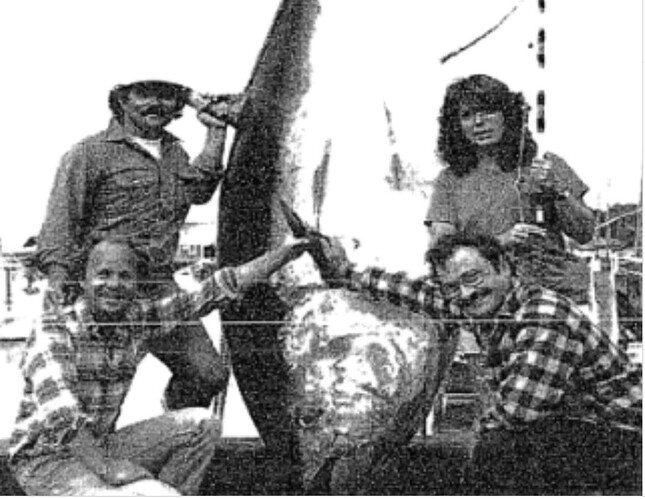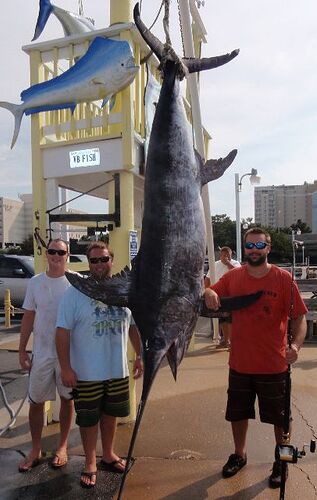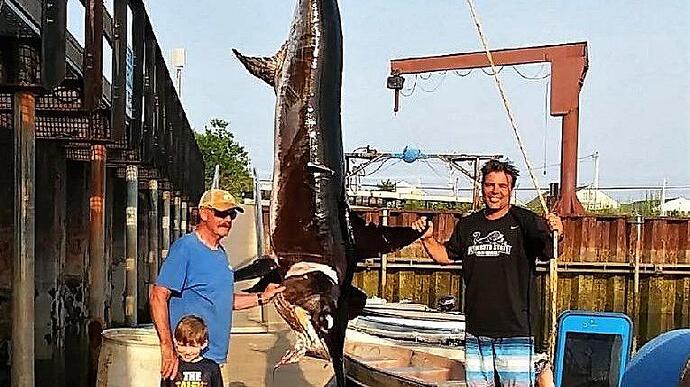“For as I like a man in whom there is something of the old, so I like a man in whom there is something of the young; and he who follows this maxim, in body will possibly be an old man but he will never be an old man in mind.”
― Marcus Tullius Cicero
This will now be integrated into the Master “Positive Changes” document, with all the data.
My mailing list members get fresh electronic copies of the documents as they are revised and published.
The fish records document will continue to be added to.
A STUDY OF FISH GROWTH RATES DOCUMENTING THAT THE SIZE, FERTILITY, LONGEVITY AND VERY EXISTENCE OF ANY ORGANISM VARIES DIRECTLY WITH THE HEALTH OF THE ETHER - FROM “POSITIVE CHANGES THAT ARE OCCURRING”, BY JEFF MILLER, JULY 2025
Great positive changes are underway at every level of our reality. They began in earnest in 2012, and have been increasing in speed and magnitude. I began writing this series of articles, entitled “Positive Changes That Are Occurring”, in July of 2013.
The Ether is the fifth element (Earth, Wind, Fire, Water, Ether). That element was written out of the script so that the malefic, genetically-related cult of Death worshippers who could have the field of subtle energy to themselves, and work woe upon humanity with it thereby.
There is a large, ancient, and very powerful Death energy collection and distribution network that has nothing to do with “modern” technology. It’s got stone structures of careful design positioned just as carefully at key points on the Earth’s energy grid. Human sacrifices have been regularly, nay, religiously performed at such sites all the way back to Babylon, and before, with every one of those sacrifices driving Death energy into the grid.
You can’t see it, you can’t smell it, but it’s real, and it’s there. That Death energy is what Wilhelm Reich called “Dead Orgone Radiation”. And its impact upon life forms may be observed.
The health of the Ether is inexorably returning to its natural state of health and vitality.
One of those changes is that fish growth rates are increasing exponentially, regardless of species or geography.
While Western Materialsm falsely purports that an organism will grow in ever-smaller increments to a genetically-programmed maximum possible size.
Another great positive change taking place currently is that supposedly “extinct” species are returning to existence in their old habitats, while other fish species are appearing where they have never been documented previously.
That’s because the health of the ether is inexorably improving, and the size, fertility, longevity and very existence vary directly with the health of the ether, as I demonstrate below.
From 1903 to 2024, the swordfish in California increased in size by an annual average of 3%.
From 1903 to 2024, the swordfish in California increased in size by 342.6%, or by almost three and a half times, or by 513.9 pounds, from 150 pounds to 663.9 pounds.
Now let’s look at the pictures next to one another:


(The record 150-pound swordfish from Catalina Island, California from 1903, and Luc Oldfield with the current 663.9-pound California state record swordfish, San Diego, California, October 20, 2024)
“The Party told you to reject the evidence of your eyes and ears. It was their final, most essential command.”
― From “1984”, by George Orwell, 1949
From 1903 to 2021, the swordfish in North America increased in size by an annual average of 3.8%.
From 1903 to 2021, the swordfish in North America increased in size by 411.8%, or by more than five times, or by 617.8 pounds, from 150 pounds (Catalina Island, California) to 767.8 pounds (St. Lucie, Florida).
From 1903 to 1958, the swordfish in California increased in size by an annual average of 2.8%.
From 1903 to 1958, the swordfish in California increased in size by 151.8%, or by 227 pounds, 12 ounces, pounds, from 150 pounds to 377 pounds, 12 ounces.
On July 6, 1958, an unspecified “record” swordfish was caught off San Clemente island in California. It weighed 377 pounds, 12 ounces. Can you see how what type of record it was has been obfuscated? They far larger world record holder from the 1930’s has been memory-holed. Wikipedia - and everyone else - are all steadfastly pretending that it never existed.
From 1903 to 1935 (estimated), the Pacific Ocean off Santa Catalina island in Southern California was the only place in the world that swordfish, or billfish of any kind manifested.
From 1903 to 1935 (estimated), the swordfish in California increased in size by an annual average of 8.8%
From 1903 to 1935 (estimated), the swordfish in California increased in size by 280.6%, or by almost four times, or by 421 pounds, from 150 pounds, (Catalina Island) to 571 pounds (Catalina Island).
From 1903 to 1915, the swordfish in California increased in size by an annual average of 7.8%.
From 1903 to 1915, the 7.8% average annual increase in size of the swordfish in California was 105.2% greater, or more than two times greater than its 3.8% average annual increase from 1903 to 2024.
From 1903 to 1915, the swordfish in California increased in size by 94%, or close to doubled in size, from 150 pounds (Santa Catalina Island, California) to 292 pounds (Santa Catalina Island, California).
In 1903, the record swordfish taken off Catalina Island in Southern California weighed 150 pounds.

(Record swordfish, Catalina Island, California, 1903, 150 pounds)
From 1915 to 1917, the swordfish in California increased in size by an annual average of 22.5%.
From 1915 to 1917, the world record swordfish increased in size by 45%, from 292 pounds (Catalina Island, California) to 422 pounds (Catalina Island, California). That’s an average annual increase in size of 24.5% per year over each of those two years.
From 1915 to 1917, the 22.5% average annual increase in size of the swordfish was 188.4% greater, or almost three times greater than its 7.8% average annual increase in size from 1903 to 1915.
The swordfish is increasing hyper-exponentially in size, because the health of the ether is inexorably improving, and the size, fertility, longevity and very existence of any organism vary directly with the health of the ether.
In 1915, Colonel John Sterns and George Farnsworth caught a swordfish off Santa Catalina Island in Southern California. It weighed 292 pounds
From 1917 to 1935 (estimated), the swordfish in California increased in size by an annual average of 2%.
From 1917 to 1935 (estimated) the swordfish in California increased in size by 35.3%, from 422 pounds (Catalina Island, California, world record) to 571 pounds (Catalina Island, California, world record).
From 1917 to 1935 (estimated), the 2% average annual increase in size of the swordfish in California was 91.8% less than its 24.5% average annual increase from 1915 to 1917, and 74.4% less than its 7.8% average annual increase from 1903 to 1915.
The growth rate of the swordfish in California decreased exponentially from 1917 to 1935 (estimated) because of the cumulative poisoning of the ether by electrical grids, the telegraph, and radio.
On July 20, 1917, the world record swordfish was caught by A.C. Parsons off Catalina Island in Southern California. It weighed 422 pounds.
Sometime in the 1930’s, the world record swordfish was caught off Catalina Island in Southern California. It weighed 571 pounds.
A current Wikipedia article contains this picture of a postcard made from a photograph of it:
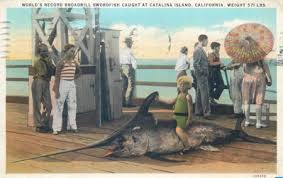
(The picture’s caption reads “World’s Record Broadbill Swordfish caught at Catalina Island, California. Weight 571 lbs.”)
From 1935 (estimated, for “sometime in the 1930’s”) to 1958, the swordfish is absent from the record.
During that time period, the health of the ether had been degraded to the point where the species could not manifest within it.
On July 6, 1958, an unspecified “record” swordfish was caught off San Clemente island in California. It weighed 377 pounds, 12 ounces. Can you see how what type of record it was has been obfuscated? They far larger world record holder from the 1930’s has been memory-holed. Wikipedia - and everyone else - are all steadfastly pretending that it never existed.
From 1935 to 2018, the largest swordfish in this study increased in size by an annual average of .8%.
From 1935 to 2018, the largest swordfish in this study increased in size by 68.4%, or by 392.6 pounds, from 571 pounds (Catalina Island, California) to 961.6 pounds (Australia record).
It took eighty three years for the size of the Catalina Island record swordfish to be exceeded.
From 1935 (estimated) to 1958, the swordfish in California decreased in size by an annual average of 1.5%
From 1935 to 1958, the 1.5% average annual increase in size of the swordfish in California was 84.7% less than its 8.8% average annual increase in size from 1903 to 1935.
The growth rate of the swordfish in California is decreasing exponentially because the health of the ether is being degraded by what we collectively refer to as “technology”, to this point electrical grids, telegraph, radio, radar and television.
From 1935 (estimated) to 2024, the swordfish in California increased in size by an annual average of .2%.
From 1935 (estimated) to 2024, the swordfish in California increased in size by 16.3%, or by 92.9 pounds, from 571 pounds (San Clemente Island) to 663.9 pounds (San Diego).
From 1935 (estimated) to 1958, the swordfish in California decreased in size by 33.9%, or by 193 pounds, 4 ounces, or by one third, from 571 pounds (San Clemente Island, California) to 377 pounds, 12 ounces (San Clemente Island, California).
From 1958 to 2003, there are no examples of the swordfish anywhere in the historical record for which independent media accounts and photographs exist.
The species had been driven out of existence by microwave radiation’s poisoning of the ether.
From 1958 to 2003, the swordfish in California increased in size by an annual average of .44%.
From 1958 to 2003, the .44% average annual increase in size of the swordfish in California was 84.3% less than its 2.8% average annual increase in size from 1903 to 1958.
From 1958 to 2003 versus 1903 to 1958, the 84.3% negative variance in the average annual increase in size of the swordfish in California and its 84.7% negative variance from 1935 to 1958 versus 1903 to 1935 were statistically identical.
From 1958 to 2003, the swordfish in California increased in size by 19.8%, from 377 pounds, 12 ounces (San Clemente Island, California) to 452 pounds, 8 ounces (San Clemente Island California).
From 1971 to 2024, there are twenty bluefin tuna state records in the United States.
The USGS table for the species shows that the Atlantic bluefins is native to both the western and eastern Atlantic Ocean.
Yet there is no Georgia state record bluefin tuna, nor is there a Rhode Island state record bluefin tuna. Why?
From 1971 to 2024, there have been twenty claimed bluefin tuna state records: Rhode Island (1971), Maryland (1975), New York (1977), Maine rod and reel (1977), Maine harpoon (1981), New Jersey (1981), Massachusetts (1984), Connecticut (2000), Virginia (2003), Delaware (2005), South Carolina (2006), Virginia (2007), North Carolina (2011), New Hampshire (2013), Washington (2014), Virginia (2015), Florida (2017) and Alabama (2024)
The USGS table for the species shows that the Atlantic bluefins is native to both the western and eastern Atlantic Ocean.
Yet there are no state records for the bluefin tuna prior to 1971. Why?
The USGS species map for the bluefin tuna documents its range prior to the degradation of the health of the ether.
From 1971 to 2024, seven of the twenty, or 35% of the bluefin tuna state records are fabricated, e.g., are not verified by independent media documentation or photographs: Rhode Island (1971), Maryland (1975), New York (1977), Maine harpoon (1981), New Hampshire (2001), Virginia (June 6, 2023), Virginia (November 5, 2003).
In September 1971, it is claimed that J. Dempsey caught the first, only and current Rhode Island state record bluefin tuna off Block Island, and that it weighed 1,142 pounds, 12 ounces.
The USGS table for the species shows that the Atlantic bluefins is native to both the western and eastern Atlantic Ocean. Yet there is no Rhode Island state record for the bluefin tuna until 1971. Why?
The USGS species map for the bluefin tuna documents its range prior to the degradation of the health of the ether.
There are no independent media accounts of the catch, nor are there any photographs of the fish.
The 1971 Rhode Island state record bluefin tuna is fabricated.
In 1972, it is claimed that a New Hampshire state record swordfish which weighed 646 pounds was harpooned, and that “It was sold to a licensed fish buyer”.
Despite the fact that the swordfish is native to the Atlantic Ocean, there are no New Hampshire state record swordfish for which independent media verification and photographs exist.
The 1972 New Hampshire state record swordfish is fabricated.
On August 30, 1975, it is purported that James Daniels IV caught the first, only and current Maryland state record bluefin tuna, and that it weighed 625 pounds.
However, there are no independent media accounts of the catch, nor are there any photographs of the fish.
The USGS table for the species shows that the Atlantic bluefin tuna is native to both the western and eastern Atlantic Ocean. Yet there was no Maryland state record for the bluefin tuna until 1971. Why?
It is a fabricated state fish record.
In August 1977, it is purported that Jerry Jamison caught the first-ever Maine state record bluefin tuna, weighing 819 pounds.
The USGS table for the species shows that the Atlantic bluefin tuna is native to both the western and eastern Atlantic Ocean. Yet there was no Maine state record for the bluefin tuna until 1977. Why?
Further, there are no independent media accounts of the catch, nor are there any photographs of the fish.
It is a fabricated state fish record.
AI says “This record stood for a number of years”.
The truth of the matter is that, in 2024, the bluefin tuna winked into existence in the Atlantic Ocean off Maine, where it had never been documented previously, as the health of the ether improved to the point where the species could manifest within it.
On August 21, 1977, it is claimed that Larry Thompson caught the first, only and current New York state record for bluefin tuna off Montauk, Long Island, and that it weighed 1,071 pounds.
The USGS table for the species shows that the Atlantic bluefin tuna is native to both the western and eastern Atlantic Ocean. Yet there was no New York state record for the bluefin tuna until 1971. Why?
Further, there are no independent media accounts of the catch, nor are there any photographs of the fish.
It is a fabricated state fish record.
There are no documented examples of the bluefin tuna in New York for which independent media verification or photographs exist.
In 1978, it is claimed that Albert Scott caught the first-ever Delaware state record swordfish which weighed 276 pounds, 12 ounces.
However, there are no independent media accounts of the catch, nor are there any photographs of the fish.
It is a fabricated state fish record.
The truth of the matter is that, in 2013, the swordfish winked into existence in the Atlantic Ocean off Delaware, where it had never been documented previously, as the health of the ether improved to the point where the species could manifest within it.
On May 7, 1978, it is purported that Stephen Stanford caught the first-ever Florida state record swordfish, and that it weighed 612.75 pounds.
On March 30, 2012, sportfishingmag.com’s Doug Olander said in comment “Stanczyk said a 612.75-pound broadbill was caught off Key Largo at night. That fish, reeled in May 7, 1978, by Stephen Stanford, is still a state record, according to the Florida Fish and Wildlife Conservation Commission.”
However, there are no independent media accounts of the catch, nor are there any photographs of the fish.
It is a fabricated state fish record.
In fact, the swordfish winked into existence in the Atlantic Ocean off Florida for the first time in history in 2003, as the health of the ether improved to the point where the species could manifest within it.
In 1979, sc.gov states that T.C. Lewis caught the South Carolina state record yellowfin tuna, and that it weighed 241 pounds, 12 ounces.
However, there are no independent news accounts documenting the catch, and there are no photographs of this fish. Why?
The USGS table for the species states that Yellowfin tuna inhabit tropical and subtropical waters worldwide, including the Atlantic, Pacific, and Indian Oceans.
Yet there is no North Carolina state record for the yellowfin tuna until 1979. Why?
It is a fabricated state fish record.
The truth of the matter is that, In 1979, the blue catfish winked into existence in Georgia, where it had never been documented previously, as the health of the ether improved to the point where the species could manifest within it.
On October 11, 1978, it is purported that James Alexander caught the first-ever Virginia state record swordfish, and that it weighed 381 pounds, 8 ounces.
However, there are no independent media accounts of the catch, nor are there any photographs of the fish.
It is a fabricated state fish record.
From 1979 to 2010, the Georgia state record blue catfish increased in size by an annual average of 1%.
From 1979 to 2010, the Georgia state record blue catfish increased in size by 29.4%, or by almost one third, or by 18 pounds, 4 ounces, from 62 pounds to 80 pounds, 4 ounces.
From 1979 to 2006, the Georgia state record blue catfish increased in size by an annual average of .33%.
From 1979 to 2006, the Georgia state record blue catfish increased in size by 8.9%, or by 5.5 pounds, from 62 pounds to 67.5 pounds.
In 1979, it is purported that the first-ever North Carolina state record swordfish was caught off Wrightsville Beach by J. Horace Murray, Jr., and that it weighed 441 pounds.
However, there are no independent media accounts of the catch, nor are there any photographs of the fish.
It is a fabricated state fish record.
In 1979, the Georgia state record blue catfish weighed 62 pounds.
There are no Georgia state record blue catfish prior to 1979.
On June 24, 1980, Julia Hurley of Cedar Bluff, Alabama caught a 10 pound, 14 ounce swordfish in Weiss Reservoir. Weiss Reservoir is a fresh water reservoir. Swordfish are saltwater fish. Weiss Reservoir does not connect with the Gulf of Mexico.
Here, signally, we have the brief manifestation of the saltwater swordfish in a landlocked freshwater reservoir, at a tiny threshold weight of ten pounds.
In July 1980, it is purported that Tom Dentin caught the Louisiana state record broadbill swordfish in the Mississippi Canyon, and that it weighed 310 pounds.
However, there are no independent media accounts of the catch, nor are there any photographs of the fish.
It is a fabricated state fish record.
In 1981, Royal Parsons caught the first, only and current New Jersey state record bluefin tuna. It weighed 1,030 pounds.
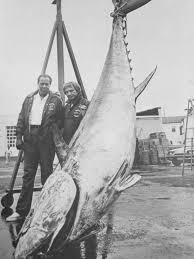
(Royal Parsons with the the first, only and current New Jersey state record bluefin tuna, 1981)
The USGS table for the species shows that the Atlantic bluefin tuna is native to both the western and eastern Atlantic Ocean. Yet there was no New York state record for the bluefin tuna until 1971. Why?
In 1981, the bluefin tuna winked into existence in the Atlantic Ocean off New Jersey for the first time in history at a weight of 1,030 pounds. It would remain in existence there only briefly. Soon after, the bluefin tuna disappeared from the environment in New Jersey and remains absent from it to this day.
On August 20, 1981, a current, uncredited article on a-z-animals.com purports that “The largest bluefin tuna ever caught in Maine weighed 1155 lbs. Anglers Tim Tower and Percy Stevens, Jr. caught the fish at Perkins Cove, Ogunquit, on August 20, 1981, elbowing the 1977 record-breaking catch by Jerry Jemison in Bath. Jemison’s catch weighed 819 lbs.”
Yet it was not and is not listed as a Maine state record. Why? Nor are there any independent media accounts or photographs documenting the fish. Why?
It is a fabricated state fish record.
From 1983 to 2023, the buffalo sucker in Ohio increased in size by an annual average of .94%.
From 1983 to 2023, the buffalo sucker in Ohio increased in size by 37.6%, or by 13.9 pounds, from 37 pounds to 50.9 pounds.
From 1982 to 2013, the buffalo sucker in Ohio increased in size by an annual average of .3%.
From 1982 to 2006, the respective .3% and .33% average annual increases in size of the Georgia state record blue catfish and of the buffalo sucker in Ohio were statistically identical.
Fish growth rates are increasing at very similar rates regardless of species or geography because the health of the ether is inexorably improving, and the size, fertility, longevity and very existence of any organism vary directly with the health of the ether.
From 1983 to 2013, the buffalo sucker in Ohio increased in size by 10.3%, or by 3.8 pounds, from 37 pounds to 40.8 pounds.
On May 14, 1983, Don Paisley caught the Ohio bowfishing state record buffalo sucker in Hoover Reservoir. It weighed 37 pounds.
In 1984, Marlene Goldstein caught a 1,228-pound bluefin tuna in Cape Cod Bay, Massachusetts, which remains the state’s record.
(Marlene Goldstein with the first, only and current Massachusetts state record bluefin tuna, 1984)
There was no Massachusetts state record bluefin tuna until 1984.
The USGS table for the species shows that the Atlantic bluefin tuna is native to both the western and eastern Atlantic Ocean. Yet there was no New York state record for the bluefin tuna until 1984. Why?
In 1984, the bluefin tuna winked into existence in Cape Cod Bay off Massachusetts, where it had never been documented previously. It weighed 1,228 pounds. It would remain in existence there only briefly. Soon after, the bluefin tuna disappeared from the environment in Massachusetts and remains absent from it to this day.
From 1985 to 2023, the Pennsylvania state record flathead catfish increased in size by an annual average of 1.4%.
From 1985 to 2023, the respective .94% and 1.4% average annual increases in size of the buffalo sucker in Ohio and the flathead catfish in Pennsylvania were statistically very similar.
Fish growth rates are increasing at very similar rates regardless of species or geography because the health of the ether is inexorably improving, and the size, fertility, longevity and very existence of any organism vary directly with the health of the ether.
From 1985 to 2023, the Pennsylvania state record flathead catfish increased in size by 52.4%, or by more than half, or by 22 pounds, 13 ounces, from 43 pounds, 9 ounces to 66 pounds, 6 ounces.
From 1985 to 2010, the respective 1% and 1.4% average annual increases in size of the Georgia state record blue catfish and the Pennsylvania state record flathead catfish were statistically almost identical.
Fish growth rates are increasing at very similar rates regardless of geography because the health of the ether is inexorably improving, and the size, fertility, longevity and very existence of any organism vary directly with the health of the ether.
From 1985 to 2006, the Pennsylvania state record flathead catfish increased in size by an annual average of .52%.
From 1985 to 2006, the Pennsylvania state record flathead catfish increased in size by 11%, or by 4 pounds, 13 ounces, from 43 pounds, 9 ounces to 48 pounds, 6 ounces.
In 1985, Seymour Abramovitz of Pittsburgh caught a Pennsylvania state record flathead catfish in the Allegheny River. It weighed 43 pounds, 9 ounces.
In 1990, it is purported that Lester Debetta caught the first, only and current Connecticut state record Bluefin Tuna, in Block Island Sound. It weighed 770 pounds, per ct.gov.
The USGS table for the species shows that the Atlantic bluefin tuna is native to both the western and eastern Atlantic Ocean. Yet there was no Connecticut state record for the bluefin tuna until 1990. Why?
There are no independent news articles or photographs documenting this fish. Why?
It is a fabricated state fish record.
In 1997, when confronted with the pound-net capture of a large Atlantic sturgeon in the Chesapeake Bay, David Secor, a professor at the University of Maryland Center for Environmental Science, Chesapeake Biological Laboratory and author of “Migration Ecology of Marine Fishes” said “What it represents, if it is a Chesapeake Bay fish, is kind of a ghost. It’s a representative of something that once was — and probably no longer is — here.”
Here’s David Secor’s picture, in a Satanic-green shirt, against a Satanic-purple background, and where he’s using a purportedly-secret Masonic “gesture of recognition”.

(University of Maryland Center for Environmental Science professor David Secor)
Now, for any Coincidence Theorists lingering in the readership, here’s a 19th Century depiction of a Freemason using the same purportedly-secret “gesture of recognition” that Professor David Secor is in the photo immediately above.

(19th Century depiction of a Freemason using a purportedly-secret “gesture of recognition”)
I have included David Secor’s picture so that you could get a better idea of what a generational Satanist Freemason of marginal influence looks like.
They all related to one another through the maternal bloodline. Generational Satanists comprise between twenty and thirty percent of the populace, and are hiding in plain sight in every city, town and village on Earth. It’s how the few have controlled the many all the way back to Babylon, and before.
But they say that the hardest part of solving a problem is recognizing that you have one.
Don Croft used to say “Parasites fear exposure above all else”.
From 1995 to 2017, the largest bluefin tuna ever caught off North Carolina increased in size by an annual average of 1.8%.
From 1995 to 2017, the respective 1.4% and 1.8% average annual increases in size of the Pennsylvania state record flathead catfish and the largest bluefin tuna ever caught off North Carolina were statistically almost identical.
Fish growth rates are increasing exponentially at very similar rates regardless of species or geography because the health of the ether is inexorably improving, and the size, fertility, longevity and very existence of any organism vary directly with the health of the ether.
From 1995 to 2017, the largest bluefin tuna ever caught off North Carolina increased in size by 40.5%, or by 301 pounds, from 744 pounds to 1,045 pounds.
From 1995 to 2011, the North Carolina state record bluefin tuna increased in size by an annual average of .5%.
From 1995 to 2011, the North Carolina state record bluefin tuna increased in size by 8.2%, or by 61 pounds, from 744 pounds to 805 pounds.
From 1995 to 2010, the respective 1%, 1.4% and 1.8% average annual increases in size of the Georgia state record blue catfish and the Pennsylvania state record flathead catfish were statistically almost identical.
Fish growth rates are increasing exponentially at very similar rates regardless of species or geography because the health of the ether is inexorably improving, and the size, fertility, longevity and very existence of any organism vary directly with the health of the ether.
In 1995, Thomas Bailey caught a North Carolina state record bluefin tuna weighing 744 pounds.
From 1997 to 2019, the Missouri state record brown trout increased in size by an annual average of 2.3%.
From 1997 to 2019, the Missouri state record brown trout increased in size by 50.6%, or by half, or by 13 pounds, 9 ounces ,from 26 pounds, 13 ounces to 40 pounds, 6 ounces.
From 1997 to 2005, the Missouri state record brown trout increased in size by an annual average of .3%
From 1997 to 2005, the Missouri state record brown trout increased in size by 2.6%, or by 11.8 ounces, from 26 pounds, 13 ounces to 27 pounds, 8.8 ounces.
From 1997 to 2000, the blue marlin in Micronesia increased in size by an annual average of 17.3%.
From 1997 to 2000, the blue marlin in Micronesia increased in size by 52%.
96% of the increase in size of the blue marlin in Micronesia from 1997 to 2019 took place from 1997 to 2000.
This sudden, hyper-exponential increase in size is the reason that the literal forest of what we collectively refer to as “cell phone towers” were thrown up virtually overnight in the late 1990’s in every city, town and village on Earth.
In 1997, the Missouri state record brown trout was caught in Bull Shoals Lake. It weighed 26 pounds, 13 ounces.
From 2000 to 2012, the blue marlin in Micronesia increased in size by an annual average of .03%.
In 2000, Don Croft invented simple, inexpensive tactical Orgonite, based upon previous work by Karl Hans Welz and Wilhelm Reich.
In 2000, the largest blue marlin ever caught in Micronesia was 52% larger than the previous record holder from 1997.
On October 13, 2000, the Hartford Courant purports that Steve Adeletti caught a 1,012 pound bluefin tuna off Connecticut, which was ruled ineligible for the state record because it was caught by a group of people.
However there are no photographs of the fish. Why?
It is a fabricated giant-fish story.
In 2001, it is claimed that Paul Wentworth, Jr. caught the first-ever New Hampshire state record bluefin tuna, and that it weighed 865 pounds.
However, there are no independent media accounts of the catch, nor are there any photographs of the fish.
It is a fabricated state fish record.
From 2003 to 2023, the California state record swordfish increased in size by an annual average of 1.5%.
The truth of the matter is that, in 2013, the bluefin tuna winked into existence in the Atlantic Ocean off New Hampshire, where it had never been documented previously, at a weight of 964 pounds, as the health of the ether improved to the point where the species could manifest within it.
From 2003 to 2023, the California state record swordfish increased in size by 15%, or by 68 pounds, from 452 pounds to 520 pounds.
From 2003 to 2021, the swordfish in Florida increased in size by an annual average of 37.1%.
From 2003 to 2021, the swordfish in Florida increased in size by 667.8%, or by almost eight times, from 100 pounds to 767.8 pounds.
From 2003 to 2020, the Virginia state record bluefin tuna increased in size by an annual average of 4.6%
From 2003 to 2020, the Virginia state record bluefin tuna increased in size by 77.8%, or by 310 pounds, from 398 pounds to 708 pounds.
From 2003 to 2007, the Virginia state record bluefin tuna increased in size by an annual average of 13%
From 2003 to 2007, the Virginia state record bluefin tuna increased in size by 52.3%, or by 175 pounds, from 398 pounds to 606 pounds.
From 2003 to 2007, the 4.6% average annual increase in size of the Virginia state record bluefin tuna was 253.8% greater, or three and a half times greater than its 1.3% average annual increase from 2007 to 2020.
The greatest rate of growth of the Virginia state record bluefin tuna took place from 2003 to 2007.
From 2003 to 2019, the swordfish in Florida increased in size by an annual average of 41.1%.
From 2003 to 2019, the 41.1% average annual increase in size of the swordfish in Florida was 5,771% greater, or more than fifty eight times greater than its .7% average annual increase in size from 2019 to 2021.
The greatest rate of growth of the swordfish in Florida is from 2003 to 2019.
From 2003 to 2019, the swordfish in Florida increased in size by 657.8%, or by more than seven and a half times, or by 657.8 pounds, from 100 pounds to 757.8 pounds.
From 2003 to 2006, the Alabama state record swordfish increased in size by an annual average of 32.9%.
From 2003 to 2006, the swordfish in the Gulf of Mexico increased in size by an annual average of 32.9%
From 2003 to 2006, the swordfish in the Gulf of Mexico increased in size by 98.8%, or by almost two times, or by 222.6 pounds, from 222.6 pounds (Alabama state record) to 448 pounds (Alabama state record).
From 2003 to 2006, the Alabama state record swordfish increased in size by 98.8%, or by almost two times, or by 222.6 pounds, from 225 pounds, 6 ounces to 448 pounds. 3606 7168
In 2003, the Stanczyk team in Islamorada, Florida caught their first swordfish.
Inthebite.com said “Modern deep drop, daytime swordfishing is attributed to the Stanczyk team fishing out of Bud and Mary’s Marina in Islamorada, Florida”.
It’s a gymnastic plausible deniability excuse trying to explain away the sudden appearance of the swordfish in Florida for the first time in history.
I was not able to locate any stories documenting the weight at which the swordfish first came into existence in the waters off Florida in 2003. We’ll eventually learn their weights.
In 2003, after an absence from this plane of existence of 45 years, the swordfish winked back into existence in California for the first time since 1958, as the health of the ether improved to the point where the species could manifest within it.
In 2003, the swordfish winked into existence in the Gulf of Mexico off Alabama for the first time in history, at a thin threshold weight of 225 pounds, 6 ounces, as the health of the ether improved to the point where the species could manifest within it.
In 2003, the swordfish winked into existence in the Atlantic Ocean off Florida for the first time in history, as the health of the ether improved to the point where the species could manifest within it.
In 2003, the bluefin tuna winked into existence in the Atlantic Ocean off Virginia for the first time in history, at weights of 393 pounds and 398 pounds, as the health of the ether improved to the point where the species could manifest within it.
In 2003, the swordfish winked into existence simultaneously in the Gulf of Mexico off Alabama and in the Atlantic Ocean off Florida for the first time in history, and winked back into existence in the Pacific Ocean off California for the first time in 45 years.
On February 5, 2003, the Sun Sentinal said “The swordfishing off South Florida has been so consistently good that it took a white marlin to get John Tedder Sr. excited”. The story mentions the catch of a 100-pound swordfish.
Where “has been so consistently good that it took a white marlin to get John Tedder Sr. excited” is a feint, covering the miraculous appearance of the swordfish in Florida for the first time in history in 2003 with a Ministry of Truth account which says “yawn”.
But, then, the key to any Confidence game is misdirection.
In November 2023, Dillon Houston caught the current California state record swordfish, off San Diego. It weighed 520 pounds.
There are no media accounts documenting any California state record swordfish prior to 2003.
Ergo, in 2003, the swordfish winked back into existence in California for the first time since X, Catalina Island, Y, as the health of the ether improved to the point where the species could once again manifest within it.
On September 30, 2003, after a 23-year absence from this material plane, the current California state record swordfish was caught off Catalina Island in Southern California, by David M. Dernholm. It weighed 452 pounds, 8 ounces. Well, if that’s true, then why isn’t the 571-pound world record swordfish taken off Catalina Island in the 1930’s mentioned?
It’s been memory-holed. Excised from existence by the folks obscuring all the rest of the data that I’m elucidating here, to their great detriment.
On October 21, 2003, Terry Bunn caught the first-ever Alabama State record swordfish. It weighed 225 pounds, 6 ounces.
There are no Alabama state record swordfish prior to 2003.
A tuscaloosanews.com article by Outdoors Writer Robert DeWitt says “Back in July 2001, the swordfish almost got Bunn. In the middle of night off Orange Beach, a large swordfish yanked Bunn into the Gulf of Mexico’s dark water and dragged him so far into its depths that he almost drowned before he detached himself from the rod and reel hooked to the fish.”
Here, DeWitt and his co-conspirator, Terry Bunn, maintain that the swordfish had been out there in the Gulf of Mexico off Alabama all along, only nobody, most notably Bunn, had pursued it with the proper skill or assiduousness, previously.
They’re doing their best to keep you from recognizing that, in 2003, the swordfish winked into existence in the Gulf of Mexico off Alabama, as the health of the ether improved to the point where the species could manifest within it.
I have to note for the record that there is only one story documenting this catch, and there are no photographs of this fish. However we’ll leave it in as a state record for now.
On November 5, 2003, Dr. James C. Wright of Virginia Beach boated a 393-pound fish that was certified as the new Virginia state record by the Virginia Saltwater Fishing Tournament. A scant 6 days later on November 11th, E.K. Morrison of Nags Head, NC landed a 398 lb., 8 oz. fish to set the latest record.
There are no Virginia state record bluefin tuna prior to 2003.
From 2005 to 2019, the 2.3% average annual increase in size of the Missouri state record brown trout was 666.6% greater, or more than seven and a half times greater than its .3% average annual increase in size from 1997 to 2005.
The growth rate of the brown trout in Missouri is increasing exponentially, because the health of the ether is inexorably improving, and the size, fertility, longevity and very existence of any organism vary directly with the health of the ether.
From 2005 to 2009, the Missouri state record brown trout increased in size by an annual average of 1.1%.
From 2005 to 2009, the Missouri state record brown trout increased in size by 4.4%, or by 1 pound, 3.2 ounces, from 27 pounds, 8.8 ounces to 28 pounds, 12 ounces. 440.8 460
From 2005 to 2009, the 1.1% average annual increase in size of the Missouri state record brown trout was 266.6% greater, or more than three and a half times greater than its .3% average annual increase from 1997 to 2005.
The growth rate of the brown trout in Missouri is increasing hyper-exponentially, because the health of the ether is inexorably improving, and the size, fertility, longevity and very existence of any organism vary directly with the health of the ether.
In 2005, the bluefin tuna winked into existence in the Atlantic Ocean off Delaware for the first time in history, at a weight of 873 pounds, as the health of the ether improved to the point where the species could manifest within it.
In March 2005, it is claimed that Anthony Taormina caught the first-ever Louisiana state record yellowfin tuna, and that it weighed 240.9 pounds.
However, there are no independent media accounts of the catch, nor are there any photographs of the fish.
It is a fabricated state fish record.
The fact of the matter is that, in 2012, the yellowfin tuna winked into existence in the Gulf of Mexico off Louisiana, where it had never been documented previously, at a weight of 251 pounds, as the health of the ether improved to the point where the species could manifest within it.
On July 16, 2005, Bryan Chapman caught the Missouri state record brown trout on Lake Taneycomo near Branson. It weighed 27 pounds 8.8 ounces.
In August 2005, a massively-amplified hurricane Katrina was driven around in the Gulf of Mexico like a bumper car and plowed directly into New Orleans.
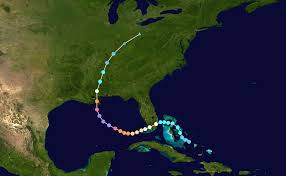
(Hurricane Katrina, pumped up and steered into New Orleans like a bumper car, 2006)
This was the, er, high-water mark of the Death-energy based storm steering and augmentation system.
In 2005, roffs.com purports that Ron Frick caught the first-ever Alabama state record swordfish, and that it weighed 350.8 lbs.
However, there are no independent media accounts documenting this catch, nor are there any photographs of this fish.
In (month) 2005, Dan Dillon caught a Delaware state record bluefin tuna. It weighed 874 pounds.
Aaron Hurd of the Division of Fish and Wildlife said it “exceeded Delaware’s previous record tuna by more than 500 pounds”, per espn.com. In a separate article, Aymar Jean of the Washington Post said “It beat the state record by more than 500 pounds”.
Neither the Delaware Division of Fish and Wildlife’s Aaron Hurd nor the Washington Post’s Aymar Jean mentioned who set the previous record, or when, or what the previous record weighed, or where it was caught because the Delaware state record bluefin tuna prior to 2005 is fabricated.
The USGS table for the species shows that the Atlantic bluefin tuna is native to both the western and eastern Atlantic Ocean. Yet there was no Delaware state record for the bluefin tuna until 2005. Why?
The USGS species map documents the range of the bluefin tuna prior to the degradation of the health of the ether.
From 2006 to 2019, the Pennsylvania state record flathead catfish increased in size by an annual average of .33%.
From 2006 to 2019, the .33% average annual increase in size of the Pennsylvania state record flathead catfish was 36.5% less, or more than one third less than its .52% average annual increase from 1985 to 2006.
Here we see the growth rate of the flathead catfish in Pennsylvania degraded by what we collectively refer to as “wireless technology”.
From 2006 to 2019, the Pennsylvania state record flathead catfish increased in size by 4.3%, or by 2 pounds, 1 ounce, from 48 pounds, 6 ounces to 50 pounds, 7 ounces. 774 807
From 2006 to 2010, the Georgia state record blue catfish increased by an annual average of 4.7%.
From 2006 to 2010, the Georgia state record blue catfish increased in size by 18.8%, or by almost one fifth, or by 12 pounds, 12 ounces, from 67 pounds, 8 ounces to 80 pounds, 4 ounces.
From 2006 to 2008, the Georgia state record blue catfish increased in size by an annual average of 5.6%.
From 2006 to 2008, the Georgia state record blue catfish increased in size by 11.1%, or by 7.5 pounds, from 67.5 pounds to 75 pounds.
From 2006 to 2008, the 5.6% average annual increase in size of the Georgia state record blue catfish was 59.9% greater, or almost two thirds greater than its 3.5% average annual increase from 2008 to 2010.
This documents that the greatest growth rate of the blue catfish in Georgia took place from 2006 to 2008.
From 2006 to 2008, the 5.6% average annual increase in size of the Georgia state record blue catfish was 1,597% greater, or seventeen times greater than its .33% average annual increase in size from 1979 to 2006.
The growth rate of the blue catfish in Georgia is increasing hyper-exponentially, because the health of the ether is inexorably improving, and the size, fertility, longevity and very existence of any organism vary directly with the health of the ether.
In 2006, a Pennsylvania state record flathead catfish was caught by James R. Sharbach, Jr. in the Blue Marsh Spillway in Berks County. It weighed 48 pounds, 6 ounces.
In 2006, the Georgia state record blue catfish weighed 67.5 pounds.
From 2006 to 2007, the swordfish in the Gulf of Mexico decreased by 83.3%, or by 373 pounds, from 448 pounds (Alabama state record) to 75 pounds (Mississippi state record).
In 2007, the iPhone was introduced.
In January 2006, the South Carolina state record for bluefin tuna was set at 396 pounds, 14 ounces, caught by J.S. Middleton III near Hilton Head Island.

(J.S. Middleton with the first, only and current South Carolina state record bluefin tuna, from 2006)
The USGS table for the species shows that the Atlantic bluefin tuna is native to both the western and eastern Atlantic Ocean. Yet there was no South Carolina state record for the bluefin tuna until 2006. Why?
The USGS map for the bluefin tuna documents its range prior to the degradation of the health of the ether.
On September 8, 2006, it is purported that Dean Delle Donna caught the first-ever New York state record swordfish. It weighed 540 pounds, per dec.ny.gov.
However, there are no independent media accounts of this catch, or are there any photographs of it.
It is a fabricated state record fish.
I have exposed the duplicity of the state government of New York by using what was known in the old days as “fact checking”.
On September 16, 2006, Del Sawyer caught the current Alabama state record swordfish in the Gulf of Mexico. It weighed 448 pounds.
An uncredited author from louisianasportsman.com said in comment “According to Alabama Outdoors, the previous record for a Swordfish caught in the Gulf of Mexico was 350 pounds, and was set in 2005 by an angler from Gulf Shores, Ala.”
The uncredited author from louisianasportsman.com did not list the name of the person who caught the fish because nobody did, in fact, catch that fish.
The Alabama state record swordfish from prior to 2006 claimed by Louisiana Sportsman is a fabricated state fish record.
There are no Alabama state records for the swordfish prior to 2006 for which independent media verification and photographs exist.
On September 20, 2006, an uncredited author from louisianasportsman.com shrilled “Angler shatters Gulf swordfish record”.
Where the general “Angler” redacts the name of the angler, “Del Sawyer”, where the general “shatters” redacts the margin between the old record and the new, where “Gulf swordfish record” redacts Gulf of Mexico” and, for good measure “Alabama”, and where the general “gulf swordfish record” redacts “Alabama state record swordfish”.
The article goes on to say “According to Alabama Outdoors, the previous record for a Swordfish caught in the Gulf of Mexico was 350 pounds, and was set in 2005 by an angler from Gulf Shores, Ala.”
Where the general “the angler” redacts the name of the angler, which was not printed because that angler does not exist. It is a fabricated state fish record.
I have exposed the duplicity of louisianasportsman.com and Alabama Outdoors by using what was known in the old days as “fact checking”.
For those unaware, anytime an author is uncredited, it is proof that said author is an Intelligence operative.
In 2006, the bluefin tuna winked into existence in the Atlantic Ocean off South Carolina, where it had never been documented previously, at a weight of 396 pounds, 14 ounces, as the health of the ether improved to the point where the species could manifest within it.
In 2006, the swordfish winked into existence in the Gulf of Mexico, where it had never been documented previously, off Alabama, as the health of the ether improved to the point where the species could manifest within it.
From 2007 to 2021, the Mississippi state record swordfish increased in size by an annual average of 22.4%.
From 2007 to 2021, the Mississippi state record swordfish increased in size by 313.2%, or by more than four times, or by 234.9 pounds, from 75 pounds to 309.9 pounds.
From 2007 to 2020, the Virginia state record bluefin tuna increased in size by an annual average of 1.3%.
From 2007 to 2020, the Virginia state record bluefin tuna increased in size by 16.8%, or by 102 pounds, from 606 pounds to 708 pounds.
From 2007 to 2017, the Mississippi state record swordfish increased in size by an annual average of 22.3%.
From 2007 to 2017, the 22.3% average annual increase in the size of the swordfish in the Gulf of Mexico was 126.9% greater, or more than two times greater than its 83.3% decrease from 2006 to 2007.
The growth rate of the swordfish in the Gulf of Mexico is increasing exponentially, because the health of the ether is inexorably improving, and the size, fertility, longevity and very existence of any organism varies directly with the health of the ether.
From 2007 to 2017, the Mississippi state record swordfish increased in size by an annual average of 22.3%.
From 2007 to 2017, the 22.3% average annual increase in the size of the Mississippi state record swordfish was 221.3% greater, or more than three times greater than its 6.9% average annual increase from 2017 to 2021.
The greatest rate of growth of the Mississippi state record swordfish was documented from 2007 to 2017.
From 2007 to 2017, the Mississippi state record swordfish increased in size by 223.4%, or by more than three times, or by 167.5 pounds, from 75 pounds to 242 pounds, 8.64 ounces.
From 2007 to 2013, the swordfish in the Gulf of Mexico increased in size by 557.3%, or by more than six and a half times, 418 pounds, or by from 75 pounds (Mississippi state record) to 493 pounds (Texas state record)
From 2007 to 2012, the swordfish in this study increased in size by an annual average of 98.9%.
From 2007 to 2012, the 98.9% average annual increase in size of the swordfish in this study was 218.7% greater, or more than three times greater than its 83.3% decrease from 2006 to 2007.
The growth rate of the swordfish is increasing exponentially, because the health of the ether is inexorably improving, and the size, fertility, longevity and very existence of any organism varies directly with the health of the ether.
From 2007 to 2012, the swordfish in this study increased in size by 494.6%, or almost six times, or by 371 pounds, from 75 pounds (Mississippi state record) to 446 pounds (Virginia state record).
From 2007 to 2012, the 98.9% average annual increase in size of the swordfish in this study was 841.9% greater, or well more than nine times greater than its 10.5% increase from 2012 to 2013.
The growth rate of the swordfish is the greatest it has ever been, because the health of the ether is inexorably improving, and the size, fertility, longevity and very existence of any organism vary with the health of the ether.
The greatest rate of growth of the swordfish took place from 2007 to 2012.
In 2007, sturgeon returned to the Saco River in Maine for the first time in over 60 years.
In 2007, the sturgeon winked back into existence on the Saco River in Maine for the first time in over sixty years, as the health of the ether returned to the point where the species could once again manifest within it.
In 2007, the sturgeon winked into existence in the Gulf of Mexico off Mississippi, where it had never been documented previously, as the health of the ether improved to the point where the species could manifest within it.
In 2007, the swordfish winked into existence in the Gulf of Mexico off Mississippi, where it had never been documented previously, at a thin threshold weight of 75 pounds, as the health of the ether improved to the point where the species could manifest within it.
In 2007, the sturgeon and the surgeon winked into existence simultaneously in the Gulf of Mexico off Mississippi, where it had never been documented previously, and the sturgeon winked back into existence in the Saco river in Maine for the first time in sixty years, as the health of the ether improved to the point where these species could manifest within it.
In April 2007, Chase Robinson caught a Virginia state record bluefin tuna. It weighed 606 pounds.
In August 2007, Scott Cochran caught the first-ever Mississippi state record swordfish. It weighed 75 pounds.
There are no Mississippi state records for the swordfish prior to 2007.
From 2008 to 2010, the blue catfish in Georgia increased in size by an annual average of 3.5%.
From 2008 to 2010, the blue catfish in Georgia increased in size by 7%, or by 5 pounds, 4 ounces, from 75 pounds to 80 pounds, 4 ounces.
In 2008, the Georgia state record blue catfish weighed 75 pounds.
From 2008 to 2009, the number of Atlantic sturgeon caught in Sean’s survey in the Hudson River increased by 188%, or by almost three times, from 68 to 196.
Sean, a high school senior and the Young Naturalist of the year in 2010, said the the sudden near-tripling of the Atlantic sturgeon population from 2008 to 2009 because “In 2008, most nets were set north of the salt front.”
From 2008 to 2009, the average length of the Atlantic sturgeon caught in Sean’s survey in the Hudson River increased by 5%, from 599 millimeters to 628 millimeters.
From 2008 to 2009, the average length of the shortnosed sturgeon caught in Sean’s survey increased by 5%, from 695 millimeters to 729 millimeters.
From 2008 to 2009, the 5% average increase in length of both shortnosed sturgeon and Atlantic surgeon in the Hudson River were identical.
From 2008 to 2009, the average weight of the Atlantic sturgeon caught in Sean’s survey in the Hudson River increased by 7%, from 1,216 grams to 1,306 grams.
From 2008 to 2009, the number of shortnosed sturgeon caught in Sean’s survey in the Hudson River increased by 21%, from 48 to 58.
From 2008 to 2009, the average weight of the shortnosed sturgeon caught in Sean’s survey in the Hudson River increased by 40%, from 1,813 grams to 2,529 grams.
Sean, who was awarded “Young Naturalist of the Year” for his efforts, didn’t mention why or how the length and weight of sturgeon in the Hudson River could have increased to such a great degree in just one year, regardless of where they’d been caught in relation to the salt front.
That’s an example of the propaganda technique known as “stonewalling”.
From 2009 to 2019, the Missouri state record brown trout increased in size by an annual average of 4%.
From 2009 to 2019, the Missouri state record brown trout increased in size by 40.4%, or by 11 pounds, 9.6 ounces, from 28 pounds, 12 ounces to 40 pounds, 6 ounces. 460 646 186 11.6
From 2009 to 2019, the 4% average annual increase in size of the Missouri state record brown trout was 263.6% greater, or more than three and a half times greater than its 1.1% average annual increase from 2005 to 2009.
From 2009 to 2019, the 263.3% positive variance in the increase in size of the Missouri state record brown trout versus 2005 to 2009 and the 266.6% positive variance in the increase in size of the Missouri state record brown trout from 2005 to 2009 versus 1997 to 2005 were statistically almost identical.
From 2009 to 2013, sturgeon sampled in Lake Ontario increased by 128%, or by well more than two times, or by 117, from 91 to 208, from setlines that were decreased by 37%, or by 93 setlines from 250 to 157.
From 2009 to 2013, the sturgeon-per-setline ratio of sturgeon sampled in Lake Ontario increased by 266%, or by more than three and a half times, from 91/250 (.36 per setline) to 208/157 (1.32 per setline).
Dr. Dimitry Gorsky of the Lower Great Lakes Fish and Wildlife Conservation Office located in Basom, New York, said in comment “the early results are certainly impressive to say the least.”
That’s an example of a propaganda technique known as “damning with faint praise”.
He stressed that it was merely the “early results” to give the subconscious of the Coincidence Theorist reader the green light to say that the results would certainly trail off, going forward.
As a propagandist, Dr. Gorsky knows that many or most readers will grasp virtually any straw, no matter how thin, to remain off the hook of personal responsibility.
Here’s Dr. Dimitry Gorsky’s picture.

(Dr. Dimitry Gorsky)
I have included Dr. Dimitry Gorsky’s picture so that you could get a better idea of what a generational Satanist Freemason of marginal influence looks like.
They all related to one another through the maternal bloodline. Generational Satanists comprise between twenty and thirty percent of the populace, and are hiding in plain sight in every city, town and village on Earth. It’s how the few have controlled the many all the way back to Babylon, and before.
But they say that the hardest part of solving a problem is recognizing that you have one.
Don Croft used to say “Parasites fear exposure above all else”.In 2009, the sturgeon-per-setline ratio in Lake Ontario was .36, or 91 sturgeons from 250 setlines.
In 2009, Scott Sandusky caught a Missouri state record brown trout weighing 28 pounds and 12 ounces in Lake Taneycomo. It weighed 28 pounds, 12 ounces.
In 2009, Shayne Babich caught the first-ever Texas state record swordfish. It weighed 326 pounds.
Texassaltwaterfishingmagazine.com’s John Cochrane Wald “as they topped the old swordfish record of 314 pounds”, but did not mention an angler, or a location, or a date, ergo, fabricated record.
I have exposed the duplicity of John Cochrane and Texas Saltwater Fishing Magazine by using what was known in the old days as “fact checking”.
In 2009, the swordfish winked into existence in the Gulf of Mexico off Texas, where it had never been documented previously, at a threshold weight of 326 pounds, as the health of the ether improved to the point where the species could manifest within it.
In 2010, the Georgia state record blue catfish weighed 80 pounds, 4 ounces.
In 2010, Atlantic sturgeon returned to the Chesapeake Bay for the first time in decades.
David Secor, a professor at the University of Maryland Center for Environmental Science, Chesapeake Biological Laboratory and author of “Migration Ecology of Marine Fishes”, said “I’m kind of optimistic. I’m just pleased that we have sturgeon to talk about in the Chesapeake.”
Mr. Secor isn’t optimistic, you see, but rather only “kind of optimistic”. He’s not pleased, but rather he’s “just pleased”.
Those are examples of a propaganda technique known as “damning with faint praise”.
In 2010, the Atlantic sturgeon winked back into existence in the Chesapeake Bay for the first time in decades, as the health of the ether returned to the point where the species could once again manifest within it.
From 2011 to 2022, the bluefin tuna in North Carolina increased in size by an annual average of 1%.
From 2011 to 2022, the bluefin tuna in North Carolina increased in size by 11.8%, or by 95.1 pounds, from 805 pounds to 900.1 pounds.
From 2011 to 2017, the bluefin tuna in North Carolina increased in size by an annual average of 1.5%.
From 2011 to 2017, the largest bluefin tuna ever caught off North Carolina increased in size by an annual average of 5%.
From 2011 to 2017, the bluefin tuna in North Carolina increased in size by 8.9%, or by 72 pounds, from 805 pounds to 877 pounds.
From 2011 to 2017, the largest bluefin tuna ever caught off North Carolina increased in size by 29.8%, or by almost one third, or by 240 pounds, from 805 pounds to 1,045 pounds.
From 2011 to 2017, the 1.5% average annual increase in size of the bluefin tuna in North Carolina was 200% greater, or three times greater than its .5% average annual increase from 2017 to 2022.
From 2011 to 2017, the 5% average annual increase in size of the largest bluefin tuna ever caught off North Carolina was 900% greater, or ten times greater than the .5% average annual increase in the size of the North Carolina state record bluefin tuna from 1995 to 2011.
The greatest growth rate of the bluefin tuna in North Carolina took place from 2011 to 2017.
In 2011, Corey Schultz caught the first North Carolina state record bluefin tuna for which independent news articles and photographs exist. It weighed 805 pounds.
An uncredited article from outerbanksvoice.com said in comment “The fish he caught March 12 eclipsed the previous state high of 744 pounds set off of Oregon Inlet in 1995.”
The curiously-uncredited author did not mention the name of the person who caught the previous record because that person does not exist.
The 1995 North Carolina state record bluefin tuna state record is fabricated.
I have exposed the duplicity of outerbanksvoice.com by using what was known in the old days as “fact checking”.
The USGS table for the species shows that the Atlantic bluefin tuna is native to both the western and eastern Atlantic Ocean. Yet there is no verifiable North Carolina state record for the bluefin tuna until 2011. Why?
From 2011 to 2012, juvenile sturgeon in the Hudson River in New York increased by nearly 500%, or by almost six times.
John Waldman, a professor of biology at Queens College, said "Maybe this is indicative of a major improvement and maybe it’s just a one-year blip.”
Where “maybe it’s just a one-year blip” is an example of the propaganda technique known as “stonewalling”.
Here’s John Waldman’s picture, in Satanic purple and green, where he’s using a purportedly-secret Masonic “gesture of recognition”, and where the image is constructed to focus attention on his left eye.
(Queens College’s John Waldman, Ph.D.)
Now, for any Coincidence Theorists lingering in the readership, here’s a 19th Century depiction of a Freemason using the same purportedly-secret “gesture of recognition” that John Waldman, Ph.D. is using in the photo immediately above.

(19th Century depiction of a Freemason using a purportedly-secret “gesture of recognition”)
His left eye is highlighted because, to bloodline-linked Illuminists like John, the left eye is the “eye of Will” or the “eye of Horus”.
‘The right eye is the Eye of Ra and the left is the Eye of Horus’.”
From “Freemasonry - Religion And Belief - The 3rd Temple”
Facebook: “Welcome to the Left-Hand-Path-Network, where Satanism is not about worship, but it’s study.”
I have included John Waldman’s picture so that you could get a better idea of what generational Satanist Freemason of marginal influence looks like.
They are all related to one another through the maternal bloodline. Generational Satanists comprise between twenty and thirty percent of the populace, and are hiding in plain sight in every city, town and village on Earth.
It’s how the few have controlled the many all the way back to Babylon, and before.
But they say that the hardest part of solving a problem is recognizing that you have one.
Don Croft used to say “Parasites fear exposure above all else”.
In 2011, the bluefin tuna winked into existence in the Atlantic Ocean off North Carolina, where it had never been documented previously, at a weight of 805 pounds, as the health of the ether improved to the point where the species could manifest within it.
From 2012 to 2021, the Virginia state record swordfish increased in size by an annual average of 3%.
From 2012 to 2021, the Virginia state record swordfish increased in size by 33.8%, or by one third, or by 151 pounds, from 446 pounds to 597 pounds.
From 2012 to 2019, the blue marlin in Micronesia increased in size by an annual average of .06%.
From 2012 to 2019, the blue marlin in Micronesia increased in size by .42%.
From 2012 to 2019, the Virginia state record swordfish increased in size by an annual average of .6%.
From 2012 to 2019, the Virginia state record swordfish increased in size by 4.5%, or by 20 pounds, from 446 pounds to 466 pounds.
From 2012 to 2019, the .42% increase in size of the largest blue marlin ever caught in Micronesia was 5% greater than its .4% increase in size from 2000 to 2012.
From 2012 to 2019, the .06% average annual increase in size of the blue marlin in Micronesia was 100% greater, or two times greater than its .03% average annual increase from 2000 to 2012.
The growth rate of the blue marlin in Micronesia is increasing exponentially, because the health of the ether is inexorably improving, and the size, fertility, longevity and very existence of any organism vary directly with the health of the ether.
From 2012 to 2017, the Washington state record Pacific bluefin tuna increased in size by an annual average of 50.8%.
From 2012 to 2017, the Washington state record Pacific bluefin tuna increased in size by 152.4%, or by more than half, or by 55.7 pounds, from a threshold weight of 36.5 pounds to 92.15 pounds.
From 2012 to 2014, the Washington state record Pacific bluefin tuna increased in size by an annual average of 3.7%.
From 2012 to 2014, the Washington state record Pacific bluefin tuna increased in size by 7.4%, or by 2.7 pounds, from a threshold weight of 36.5 pounds to 39.2 pounds.
Statesmanjournal.com’s Henry Miller omitted the percentage increase, and he also omitted the weight of the 2012 record, saying only “The record topped the previous state-record bluefin by 2.71 pounds”.
Where “topped” queasily implies that the new record was just a fraction larger than the old.
In 2012, the Mayan “long count” ended.
In 2012, Patrick Fagan caught the first-ever Washington state record Pacific bluefin tuna 35 miles offshore from Westport. It weighed 36.5 pounds.
There are no Washington state record Pacific bluefin tuna prior to 2012.
The USGS table for the species states that Pacific bluefin tuna primarily inhabit the North Pacific Ocean, ranging from the eastern coast of Asia to the western coast of North America.
Well, if that’s true, then why is there no Washington state record for the Pacific bluefin tuna until 2012?
The USGS species map depicts the range of the Pacific bluefin tuna prior to the degradation of the health of the ether.
In 2012, the sturgeon winked back into existence in the James River in Richmond, Virginia for the first time in almost seventy years.
In 2012, the yellowfin tuna winked into existence in the Gulf of Mexico off Louisiana, where it had never been documented previously, at a weight of 251 pounds, as the health of the ether improved to the point where the species could manifest within it.
In 2012, the Pacific bluefin tuna winked into existence in the Pacific ocean off the state of Washington, where it had never been documented previously, at a threshold weight of 36.5 pounds, as the health of the ether improved to the point where the species could manifest within it.
In 2012, the swordfish winked into existence in the Atlantic Ocean off Virginia, where it had never been documented previously, at a threshold weight of 446 pounds, as the health of the ether improved to the point where the species could manifest within it.
In 2012, the yellowfin tuna winked into existence in the Gulf of Mexico off Louisiana, where it had never been documented previously, at a weight of 251 pounds, as the health of the ether improved to the point where the species could manifest within it.
In 2012, the yellowfin winked into existence for the first time in Gulf of Mexico off Louisiana, the Pacific bluefin tuna winked into existence in the Pacific ocean off Washington, the swordfish winked into existence in the Atlantic Ocean off Virginia, and the sturgeon winked back into existence in the James River in Virginia for the first time in almost seventy years.
From 2012 to 2013, the swordfish in this study increased in size by 10.5%, or by 47 pounds, from 446 pounds (Virginia state record) to 493 pounds (Texas state record).
On September 1, 2012, Joseph T. Harris caught the first-ever Virginia state record swordfish. It weighed 446 pounds.
(Joseph T. Harris with the first-ever Virginia state record swordfish, 2012)
There are no Virginia state records for the swordfish prior to 2012 for which independent media accounts or photographs exist.
The USGS table for the species states that “North Atlantic swordfish annually migrate thousands of miles along the eastern seaboard of the United States and Canada and also in the eastern Atlantic along Africa and Europe.”
Well, if that’s true, then why is there no Virginia state record swordfish until 2012?
The USGS species map depicts the range of the swordfish prior to the degradation of the health of the ether.
In the Fall of 2012, sturgeon returned to downtown Richmond, Virginia, where they hadn’t been seen since the 1940’s.
Greg Garman, the Director of Commonwealth University’s Center For Environmental Recovery said “People were lining the bridge, taking pictures, bringing their kids”, but didn’t offer any suggestion as to why the sudden transformation in the James River had taken place, nor did he mention that it was part of a wider trend taking place regardless of geography.
Those are examples of the propaganda technique known as “stonewalling”.
Here’s Greg Garman’s picture, against a Satanic-green Kabbalist “Tree of Life” background, and where he’s using a purportedly-secret Masonic “gesture of recognition”.

(Greg Garman, the Director of Commonwealth University’s Center For Environmental Recovery)
Now, for any Coincidence Theorists lingering in the readership, here is a 19th Century depiction of Freemasons using the same purportedly-secret “gesture of recognition” that Greg Garman is in the photo immediately above.

(19th Century depiction of Freemasons using the purportedly-secret crossed-arms “gesture of recognition”)
Joseph Hightower of N.C. State University and the U.S. Geological Survey said of the sturgeon “They are a hard-to-detect species unless they jump; they can be there but nobody knows it. They were obviously there and people just didn’t realize it.””
When, in fact, people were lining the bridge, taking pictures of the car-sized sturgeon, which were clearly visible just below the surface of the river.
John’s brazen falsehood “they are a hard-to-detect species unless they jump” is an example of the propaganda technique known as “plausible deniability”.
He’s using the “Big Lie” so favored by Hitler, Goebbels and small-town Mayors the world over to obscure the fact that the sturgeon has just winked back into existence on the James River in Richmond, Virginia, as the health of the ether improved to the point where the species could once again manifest within it.
Here’s Joseph Hightower’s picture, holding what he has described as a “hard-to-detect species”.
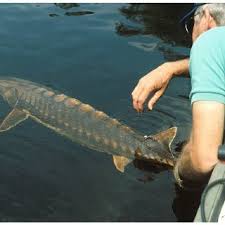
(Joseph Hightower)
I have included these pictures of Greg Carman and Joseph Hightower so that you could get a better idea of what generational Satanist Freemason of marginal influence looks like.
They are all related to one another through the maternal bloodline. Generational Satanists comprise between twenty and thirty percent of the populace, and are hiding in plain sight in every city, town and village on Earth.
It’s how the few have controlled the many all the way back to Babylon, and before.
But they say that the hardest part of solving a problem is recognizing that you have one.
Don Croft used to say “Parasites fear exposure above all else”.
In October 2012, Elliot Sale caught the first-ever Louisiana state record yellowfin tuna, weighing 251 pounds.
There are no Louisiana state record yellowfin tuna prior to 2012 for which independent media verification and photographs exist.
The USGS table for the species states that “yellowfin tuna inhabit tropical and subtropical waters worldwide, including the Atlantic, Pacific, and Indian Oceans”.
Well, if that’s true, then why is there no Louisiana state record yellowfin tuna until 2012?
The USGS species map depicts the range of the yellowfin tuna prior to the degradation of the health of the ether.
On October 1st, 2012, Patrick Fagan of Seattle, WA caught the first-ever Washington state record Bluefin tuna. It weighed 36.49 pounds.
The USGS table for the species states that “Pacific bluefin tuna primarily inhabit the temperate waters of the North Pacific Ocean, ranging from the eastern coast of Asia to the western coast of North America”.
Well, if that’s true, then why doesn’t the state of Washington have a state record Pacific bluefin tuna until 2012?
The USGS map for the species depicts the range of the bluefin tuna prior to the degradation of the health of the ether.
When, in fact, in 2012, the bluefin tuna winked into existence in the Pacific Ocean off Washington, where it had never been documented previously, at a weight of 39.2 pounds, as the health of the ether improved to the point where the species could manifest within it.
From 2013 to 2023, the buffalo sucker in Ohio increased in size by 5%, from 40.8 pounds to 45.85 pounds.
From 2013 to 2023, the 5% average annual increase in size of the Buffalo Sucker in Ohio was 1,567% greater, or more than sixteen times greater than its .3% average annual increase in size from 1983 to 2013.
The growth rate of the buffalo sucker in Ohio is increasing hyper-exponentially, because the health of the ether is inexorably improving, and the size, fertility, longevity and very existence of any organism vary directly with the health of the ether.
From 2013 to 2017, the largest swordfish in this study decreased in size by an annual average of 1.3%.
From 2013 to 2017, the largest swordfish in this study decreased in size by 5%, or by 24.8 pounds, from 493 pounds (Texas state record) to 468.2 pounds (IGFA world male junior record swordfish weighed 212.4 kilograms (468.2 pounds).
In 2013, the sturgeon-per-setline ration in Lake Ontario was 1.32, or 208 sturgeon from 157 set lines.
In 2013, the sturgeon winked back into existence in the Saco River in Maine for the first time in sixty years, as the health of the ether improved to the point where the species could once again manifest within it.
In June 2013, a 7-foot, 250-pound Atlantic sturgeon was netted in the Saco River in Maine. It was the largest ever recorded in the Saco River and the first time an Atlantic sturgeon had been seen there in 60 years.
University of New England associate professor James Sulikowski said in comment “much of the Atlantic sturgeon’s story still remains a mystery.” “We need to figure out why they’re here so we can protect them,” he said. “Are they using it as place to get stronger before they head out into an ocean migration or as a stopover on their way to another river?”
Where the hedging generalities “remains a mystery” and “figure out why they’re here” are example of the propaganda technique known as “stonewalling”, put forward to obscure the fact that, in 2013, the sturgeon winked back into existence in the Saco River in Maine for the first time in sixty years, as the health of the ether improved to the point where the species could once again manifest within it.
Professor Sulikowski, who went on to relative fame on television shows such as “Shark Week”, didn’t make any comment on the fact that the sturgeon caught in the Saco in 2013 was the largest in history, there, nor did he mention that the sudden return of the sturgeon to the Saco was part of a wider trend taking place regardless of culture or geography.
Those are examples of the propaganda technique known as “stonewalling”.
Here’s a picture of Associate Professor James Sulikowski, in a Satanic-purple shirt, against a Satanic-green Kabbalist “Tree of Life” background.

(James Sulikowski)
In February 2013, an uncredited author from the Chronicle said “Sturgeon make comeback on the Hudson”.
Where the comeback of the sturgeon is compartmentalized merely to the Hudson River.
And where the hedging generality “make comeback” covers up the specific fact that the sturgeon on the Hudson River in New York had just increased suddenly and exponentially to the largest size ever documented.
The uncredited author went on to say that scientists were “surprised by a nearly six-fold increase in the catch rate”.
Where the hedging generality “surprised” is an example of the propaganda technique known as “stonewalling”.
For those unaware, whenever an article is uncredited, you know that it has come directly from an Intelligence agency.
The article goes on to say “The department says the population appears to have doubled from 2011, the year before the Tappan Zee Bridge construction project began, through last year. John Lipscomb, a boat captain for Riverkeeper, said the new state report appears intended to counter complaints that the Tappan Zee project is causing an increase in fish deaths.”
Here, Riverkeeper John Lipscomb has queasily inferred that the report is false, has been fabricated by the people in charge of the Tappan Zee project. He’s put it forward to obscure a sudden doubling of the juvenile sturgeon in the Hudson River from 2011 to 2012.
queasily - adverb - 1. in a manner that induces the feeling of being about to vomit; nauseously, 2. in a manner that causes or expresses uneasiness
It’s an example of what is known in the Intelligence trade as “controlled opposition”, where the “watchdog” group, Riverkeeper, pretends to be on the right side of things, but is actually just another member of the Confidence game.
It’s like when the car salesman says “I have to go talk to my manager.” One plays the “good cop”, and one plays the “bad cop”, and they work both ends against the middle.
Here’s John Lipscomb’s picture, in a Satanic-green shirt, against a Satanic-green Kabbalist “Tree of Life” background, and where he’s using a purportedly-secret Masonic “gesture of recognition”.

(John Lipscomb)
For any Coincidence Theorists lingering in the readership, here’s an 18th Century depiction of a Freemason, on the left, using the same purportedly-secret “gesture of recognition” that John Lipscomb is in the photo immediately above. Note also the purportedly-random Masonic square and compass between them.
( 18th Century depiction of Freemasons greeting one another with purportedly-secret “gestures of recognition”.)
The Freemason on the right is using the sign of Satan. To maintain current programming levels, affirm that they want to “rock on”.
I have included this picture of John Lipscomb so that you could get a better idea of what generational Satanist Freemason of marginal influence looks like.
They are all related to one another through the maternal bloodline. Generational Satanists comprise between twenty and thirty percent of the populace, and are hiding in plain sight in every city, town and village on Earth.
It’s how the few have controlled the many all the way back to Babylon, and before.
But they say that the hardest part of solving a problem is recognizing that you have one.
Don Croft used to say “Parasites fear exposure above all else”
In 2013, the swordfish winked into existence in the Atlantic Ocean off Delaware, where it had never been documented previously, at a weight of 358 pounds, as the health of the ether improved to the point where the species could manifest within it.
In 2013, the swordfish winked into existence in the Gulf of Mexico off Texas, where it had never been documented previously, at a weight of 493 pounds, as the health of the ether improved to the point where the species could manifest within it.
In 2013, the bluefin tuna winked into existence in the Atlantic Ocean off New Hampshire, where it had never been documented previously, at a weight of 962 pounds, as the health of the ether improved to the point where the species could manifest within it.
In 2013, the swordfish winked into existence simultaneously in the Atlantic Ocean off Delaware and in the Gulf of Mexico off Texas and the bluefin tuna winked into existence in the Atlantic Ocean off New Hampshire.
In (month) 2013, Kurt Lorenz caught the first Delaware state record swordfish for which independent media verification and photographs exist, near Poor Man’s Canyon. It weighed 358 pounds.
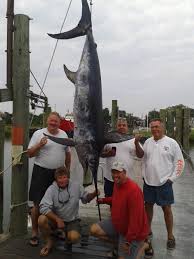
(Kurt Lorenz with the first-ever Delaware state record swordfish, 2013)
In (Month) 2013, Brent McGlone caught an Ohio bowfishing state record Buffalo Sucker in Lake Erie. It weighed 40.8 pounds.
On June 4, 2013, Brian K. Barclay caught the current Texas state record swordfish. It weighed 493 pounds. Per tpwd.texas.gov.
There are no Texas state records for the swordfish prior to 2013.
An uncredited author from pelagicgear.com said in comment, in the very last line of the article, “Still, what a catch – and record breaker – beating the old record by over 150 lbs.”
Where “what a catch” falsely implies that far larger swordfish had been out there in the Gulf of Mexico off Texas all along, only nobody had pursued them with the proper skill or assiduousness previously.
The uncredited author from pelagicgear.com didn’t mention the name of the person who caught the previous record, or the location of that catch, or the year of that catch, or the weight of that catch, because that catch did not, in fact, take place.
I have exposed the duplicity of pelagicgear.com by using what was known in the old days as “fact checking”.
For those unaware, anytime an author is uncredited, it is proof that said author is an Intelligence operative.
In August 2013, Garth Morin, Bruce DelleChiaie and Rick Green caught the first, only and current New Hampshire state record bluefin tuna. It weighed 962 pounds.
An uncredited author from onthewater.com said in comment “The previous record was set by Paul J. Wentworth, also of New Castle, in 2001 when he brought back an 865-pound bluefin.”
However, there are no independent media accounts or photographs documenting this catch.
It is a fabricated state fish record.
I have exposed the duplicity of onthewater.com by using what was known in the old days as “fact checking”.
For those unaware, anytime an author is uncredited, it is proof that said author is an Intelligence operative.
The USGS table for the species says “In the western Atlantic, bluefin tuna are found from Newfoundland to the Gulf of America”
Well, if that’s true, then why is there no New Hampshire state record bluefin tuna until 2013?
The USGS species map depicts the range of the Atlantic bluefin tuna prior to the degradation of the health of the ether.
When, in fact, in 2013, the bluefin tuna winked into existence in the Atlantic Ocean off New Hampshire at a weight of 962 pounds, as the health of the ether improved to the point where the species could manifest within it.
From 2014 to 2017, the Washington state record Pacific bluefin tuna increased in size by an annual average of 35%.
From 2014 to 2017, the Washington state record Pacific bluefin tuna increased in size by 135%, or by well more than two times, or by 52.95 pounds, from 39.2 pounds to 92.15 pounds.
From 2014 to 2017, the 35% average annual increase in size of the Washington state record Pacific bluefin tuna was 845.9% greater, or almost nine and a half times greater than its 3.7% average annual increase in size from 2012 to 2014.
The growth rate of the Pacific bluefin tuna in the Pacific Ocean off the state of Washington is increasing hyper-exponentially, because the health of the ether is inexorably improving, and the size, fertility, longevity and very existence of any organism vary directly with the health of the ether.
In 2014, Sam Ellinger caught a Washington state record Pacific bluefin tuna. It weighed 39.2 pounds.
In 2014, Brendin Page of Savannah caught the first-ever Georgia state record swordfish. It weighed 205 pounds, 8 ounces.
There are Georgia state records for the swordfish prior to 2013 for which independent media verification or photographs exist.
The uncredited author from fieldandstream.com said that Brendin’s fish “beat the previous state record by nearly 120 pounds”, and that “the previous state record was an 86-pounder caught in 1980.”
Where the uncredited author omitted the name of the person who caught the record in 1980, and also omitted any mention of where it was caught, because the person whom it is claimed caught the Georgia state record in 1980 does not, in fact, exist.
For good measure, they also omitted the margin between the old record and the new, and the name of the state, to make the subject less searchable.
Those are examples of the propaganda technique known as “stonewalling”.
I have exposed the duplicity of Field and Stream by using what was known in the old days as “fact checking”.
For those unaware, anytime an author is uncredited, it is proof that said author is an Intelligence operative.
In 2014, Atlantic sturgeon were once again spawning at the mouth of the James River in Virginia.
In 2014, the Atlantic sturgeon winked back into existence in the Chesapeake Bay for the first time in decades.
In 2014, the Atlantic sturgeon winked back into existence in the Connecticut river for the first time in decades.
In 2014, the swordfish winked into existence in the Atlantic Ocean off Georgia, where it had never been documented previously, as the health of the ether improved to the point where the species could manifest within it.
In 2014, the Atlantic sturgeon winked back into existence for the first time in decades in both the Chesapeake Bay and in the Connecticut River, and the swordfish winked into existence in the Atlantic Ocean off Georgia for the first time in history, as the health of the ether improved to the point where these species could manifest within it.
In May 2014, Atlantic sturgeon returned to the Connecticut river for the first time in decades.
An uncredited article from fishingnortheast.net said in comment “Native Connecticut River Atlantic Sturgeon Have Been Found”.
Where “have been found” bravely avers that the car-sized sturgeon had been out there in the Connecticut River all along, only nobody had looked for them with the proper skill ro assiduousness, previously.
For those unaware, anytime an author is uncredited, it is proof that said author is an Intelligence operative.
Albert Spells, Virginia fisheries coordinator with the U.S. Fish and Wildlife Service, said in comment ““The thing is, you’ve got to look and nobody was looking at sturgeon. We just were not putting enough effort into this animal.”
It’s bold, it’s brazen, and it’s ridiculous for Albert to state that a fish the size of a car, and which leaps from the water in a spectacular display known as “breaching”, could have been there, all along, only nobody had looked for them with the proper skill or assiduousness, previously.
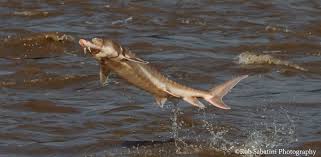
(Sturgeon breaching)
Here’s a picture of Virginia fisheries coordinator Albert Spells, where he’s using a purportedly-secret Masonic “gesture of recognition”, and where the image is constructed to focus attention on his left eye.

(Virginia fisheries coordinator Albert Spells)
And, now, for any Coincidence Theorists lingering in the readership, here is a 19th Century depiction of a variety of purportedly-secret Masonic “gestures of recognition”, including the “pointing finger” gesture that Albert Spells is using in the photo immediately above.

(19th Century depiction of a variety of purportedly-secret Masonic “gestures of recognition”)
His left eye is highlighted because, to bloodline-linked Illuminists like Albert, the left eye is the “eye of Will” or the “eye of Horus”.
‘The right eye is the Eye of Ra and the left is the Eye of Horus’.”
From “Freemasonry - Religion And Belief - The 3rd Temple”
Facebook: “Welcome to the Left-Hand-Path-Network, where Satanism is not about worship, but it’s study.”
I have included this picture of the plainspokenly-named Albert Spells so that you could get a better idea of what generational Satanist Freemason of marginal influence looks like.
They are all related to one another through the maternal bloodline. Generational Satanists comprise between twenty and thirty percent of the populace, and are hiding in plain sight in every city, town and village on Earth.
It’s how the few have controlled the many all the way back to Babylon, and before.
But they say that the hardest part of solving a problem is recognizing that you have one.
Don Croft used to say “Parasites fear exposure above all else”.
In (month) 2014, Sam Ellinger of Ellensburg, Washington, caught the Washington state record Pacific bluefin tuna. The fish weighed 39.20 pounds and was 41 inches long.
On February 11, 2014, an uncredited author from abc30.com said in comment “The previous record is 341 pounds and 124 inches, set back in January 2011.”
The uncredited author from abc30.com didn’t mention the name of the person who caught the previous record, or the location of the catch, because the catch did not, in fact, take place.
I have exposed the duplicity of abc30.com by using what was known in the old days as “fact checking”.
For those unaware, anytime an author is uncredited, it is proof that said author is an Intelligence operative.
In 2015, sturgeon on the Hudson River were at the highest level in the 10-year history of the Federal survey. The article provided no statistics whatsoever.
That is an example of the propaganda technique known as “stonewalling”.
From 2017 to 2022, the bluefin tuna in North Carolina increase in size by an annual average of .5%.
From 2017 to 2022, the bluefin tuna in North Carolina increase in size by 2.6%, or by 23.1 pounds, from 877 pounds to 900.1 pounds.
In both 2017 and 2021, all-time swordfish records were set in both Mississippi and New Zealand.
From 2017 to 2021, the Mississippi state record swordfish increased in size by an annual average of 6.9%.
From 2017 to 2021, the IGFA world male junior record swordfish increased in size by an annual average of 8.25%.
From 2017 to 2021, the respective 6.9% and 8.25% average annual increases in size of the Mississippi state record swordfish and the the IGFA world male junior record swordfish were statistically very similar.
The swordfish is increasing exponentially in size at very similar rates regardless of geography, because the health of the ether is inexorably improving, and the size, fertility, longevity and very existence of any organism vary with the health of the ether.
From 2017 to 2021, the Mississippi state record swordfish increased in size by 27.7%, or by almost one third, or by 67.36 pounds, from 242 pounds, 8.64 ounces to 309 pounds, 14.4 ounces.
From 2017 to 2021, the IGFA world male junior record swordfish increased in size by 33%, or by 155.2 pounds, from 212.4 kilograms (468.2 pounds) to 282.8 kilograms (623.4 pounds).
In 2017, after an absence of almost twenty years, the bluefin tuna winked back into existence in Maine, for the first time since 1998, as the ether once again improved in health to the point where the species could manifest within it.
In (month) 2017, the largest bluefin tuna ever caught off North Carolina weighed 1,045 pounds.
It was ruled ineligible for the state record because it was sold commercially.
In (month) 2017, the IGFA world male junior record swordfish weighed 212.4 kilograms (468.2 pounds).
In (month) 2017, Scott Chambers caught the current North Carolina state record bluefin tuna. It weighed 877 pounds.
In June 2017, Scotty Cochran caught a Mississippi state record swordfish. It weighed 242 pounds, 8.64 ounces.
From 2017 to 2018, the swordfish in this study increased in size by 105%, or by more than two times, or by 493.4 pounds, from 468.2 pounds (IGFA world male junior record) to 961.6 pounds (Australian record).
From 2017 to 2018, the 105% increase in size of the swordfish in this study was 6.1% greater than its 98.9% average annual increase from 2007 to 2012.
From 2017 to 2018, the 105% increase in size of the swordfish in this study was 8,177% greater, or more than eighty two times greater than its 1.3% average annual decrease from 2013 to 2017.
The growth rate of the swordfish is the greatest it has ever been, because the health of the ether is inexorably improving, and the size, fertility, longevity and very existence of any organism vary with the health of the ether.
In 2018, the swordfish winked into existence in the Atlantic Ocean off New Hampshire, where it had never been documented previously, as the ether improved in health to the point where the species could manifest within it.
In 2018, the Australian record swordfish weighed 961.6 pounds.
From April 2018 to May 2018, the Australian record swordfish increased in size by 24%, or by 192.6 pounds, from 349 kilograms (769 pounds) to 436.2 kilograms (961.6 pounds).
In April 2018, the Australian record swordfish weighed 349 kilograms (769 pounds).
In May 2018, the Australian record swordfish weighed 436.2 kilograms (961.6 pounds).
In July 2018, Ted Sutton harpooned the first New Hampshire state record swordfish for which independent media documentation and photographs exist. It weighed 600 pounds.
(Ted Sutton with the first-ever New Hampshire state record swordfish, July 2018)
From 2019 to 2023, the Pennsylvania state record flathead catfish increased in size by an annual average of 7.9%.
From 2019 to 2023, the Pennsylvania state record flathead catfish increased in size by 31.6%, or by almost one third, or by 16 pounds, from 50 pounds, 7 ounces to 66 pounds, 6 ounces.
From 2019 to 2023, the 7.9% average annual increase in size of the Pennsylvania state record flathead catfish was 2,294% greater, or more than twenty three times greater than its .33% average annual increase from 2006 to 2019.
The growth rate of the flathead catfish in Pennsylvania is increasing hyper-exponentially, because the health of the ether is inexorably improving, and the size, fertility, longevity and very existence of any organism vary directly with the health of the ether.
From 2019 to 2021, the Florida state record swordfish increased in size by an annual average of .7%.
From 2019 to 2021, the Florida state record swordfish increased in size by 1.3%, or by ten pounds, from 757.8 pounds to 767.8 pounds.
From 2019 to 2021, the Virginia state record swordfish increased by an annual average of 14%.
From 2019 to 2021, the Virginia state record swordfish increased in size by 28.1%, or by 131 pounds, from 466 pounds to 597 pounds.
From 2019 to 2021, the .65% average annual increase in size of the swordfish in Florida was 140.7% greater, or almost two and a half times greater than its .27% average annual increase in size from 1978 to 2021.
The growth rate of the swordfish in Florida is increasing exponentially, because the health of the ether is inexorably improving, and the size, fertility, longevity and very existence of any organism vary directly with the health of the ether.
From 2019 to 2021, the 14.5% average annual increase in size of the Virginia state record swordfish was 2,316% greater, or more than twenty four times greater than its .6% average annual increase from 2012 to 2019.
The growth rate of the swordfish in Virginia is increasing exponentially, because the health of the ether is inexorably improving, and the size, fertility, longevity and very existence of any organism varies directly with the health of the ether.
In 2019, the largest sturgeon ever documented in the Hudson River was captured on sonar. It was 14 feet long, weighed an estimated 800 pounds and was an estimated 75 years old.
University of Delaware geologist John A. Madsen told National Geographic in comment “When I first saw it, I said, "You’ve got to be kidding me.”
Where the hedging generality “you’ve got to be kidding me” gives the subconscious of the Coincidence Theorist reader the green light to say “you’ve got to be kidding me.”
As a propagandist, John knows that many or most readers will grasp virtually any straw, no matter how thin, to remain off the hook of personal responsibility.
Tom Lake, a consulting naturalist with the Hudson River Estuary Program, said in comment on the largest sturgeon in the history of the world “I remember working… on sturgeon in the Hudson River a long time ago, when a sturgeon of this size seemed mythical. We heard stories from ‘old timers’ of sturgeon 14-feet long. Of course we never believed them.”
Where the hedging generality “of course we never believed them” gives the subconscious of the Coincidence Theorist reader the green light to say “of course I don’t believe it.”
As a propagandist, Tom knows that many or most readers will grasp virtually any straw, no matter how thin, to remain off the hook of personal responsibility.
Neither University of Delaware geologist John A. Madsen nor Hudson River Estuary Program consulting naturalist Tom Lake mentioned that the sudden, exponential increase in the number and size of sturgeon in the Hudson River mapped against similar increases being seen across the species’ range, regardless of geography. That’s an example of the propaganda technique known as “stonewalling”.
Here’s John Madsen’s picture, in a Satanic-puprle sweater.

(University of Delaware geologist John A. Madsen)
Here’s Tom Lake’s picture, against a Satanic-green Kabbalist “Tree of Life” background, and where the image is constructed to focus attention on his left eye.

(Hudson River Estuary Program consulting naturalist Tom Lake)
His left eye is highlighted because, to bloodline-linked Illuminists like Tom, the left eye is the “eye of Will” or the “eye of Horus”.
‘The right eye is the Eye of Ra and the left is the Eye of Horus’.”
From “Freemasonry - Religion And Belief - The 3rd Temple”
Facebook: “Welcome to the Left-Hand-Path-Network, where Satanism is not about worship, but it’s study.”
I have included John Madden and Tom Lake’s pictures so that you could get a better idea of what generational Satanist Freemasons of marginal influence look like.
They are all related to one another through the maternal bloodline. Generational Satanists comprise between twenty and thirty percent of the populace, and are hiding in plain sight in every city, town and village on Earth.
It’s how the few have controlled the many all the way back to Babylon, and before.
But they say that the hardest part of solving a problem is recognizing that you have one.
Don Croft used to say “Parasites fear exposure above all else”.
In 2019, the swordfish winked back into existence in Florida for the first time in over fifteen years, since it had first manifested there in 2003, as the health of the ether returned to the point where the species could once again manifest within it, because the size, fertility, longevity and the very existence of any organism vary directly with the health of the ether.
In 2019, the swordfish in the Hudson River increased exponentially in size to the greatest in history, because the health of the ether is inexorably improving, and the size, fertility, longevity and the very existence of any organism vary directly with the health of the ether.
In February 2019, mprnews.com’s Tim Nelson said “Monster sturgeon pulled from St. Croix may be biggest-ever Minnesota fish”.

(Minnesota State Record Sturgeon, February 2019)
Where the hedging generality “monster” gives the subconscious of the Coincidence Theorist reader the green light to say “oh, but that monster is just a genetic anomaly!”
And where “pulled from St. Croix” suggests that far-larger sturgeon had been out there in the St. Croix river all along, only nobody had pulled them with the proper skill or assiduousness, previously.
As a propagandist, Tim knows that many or most readers will grasp virtually any straw, no matter how thin, to remain off the hook of personal responsibility.
Tom didn’t mention that sturgeon were increasing exponentially in size to the largest in history regardless of geography.
That is an example of the propaganda technique known as “stonewalling”.
On April 6, 2019, Jeff Bonawitz caught a Pennsylvania state record flathead catfish in the Susquehanna River in Lancaster County. It weighed 50 pounds, 7 ounces.
In July 2019, the Christian Science Monitor published “Sturgeon population makes comeback after near extinction”, written by the Associated Press’ Ben Finley, Patrick Whittle, and John Flesher.
Where the Christian Science Monitor referred to environments where the sturgeon had been driven into extinction with the bald-faced lie “near extinction”.
And where Finley et al used the hedging generality “makes a comeback” to obscure the fact that the sturgeon was winking back into existence in all of its old habitats, which it had inhabited until microwave radiation damaged the ether to a point where the species could no longer manifest within it.
The hedging generality “sturgeon population” obscures which population, specifically, that the authors are referring to.
That is an example of the propaganda technique known as “stonewalling”.
The article says the 78-inch sturgeon was “5 inches longer than the current state catch-and-release record set last year.”
Finley, et al used the hedging generality “5 inches longer” to avoid using a more-impactful percentage increase, which would go badly-off-message re: Poor Mother Gaia dying, and all.
So I had to do the math. From 2018 to 2019, the Chesapeake Bay catch-and-release sturgeon increased in size by 28%, or by almost one third, to 120 pounds, to the largest in history.
Greg Garman, a Virginia Commonwealth University ecologist who studies Atlantic sturgeon in Virginia’s James River, went on to say “It’s really been a dramatic reversal of fortune. We didn’t think they were there, frankly. Now, they’re almost every place we’re looking."
Virginia Commonwealth University ecologist Greg Garman is driving home the false meme that the car-sized fish, which jumps from the water in a spectacular display known as “breaching”, had been there, all along, only no one had looked for it with the proper skill or assiduousness, previously.
As a propagandist, Tim knows that many or most readers will grasp virtually any straw, no matter how thin, to remain off the hook of personal responsibility.
He’s desperate to keep you from recognizing that the size, fertility, longevity, and very existence of any organism varies directly with the health of the ether.
Here’s Ben Finley’s picture, where the picture is constructed to focus attention on his left eye.

(Ben Finley)
His left eye is highlighted because, to bloodline-linked Illuminists like Tom, the left eye is the “eye of Will” or the “eye of Horus”.
‘The right eye is the Eye of Ra and the left is the Eye of Horus’.”
From “Freemasonry - Religion And Belief - The 3rd Temple”
Facebook: “Welcome to the Left-Hand-Path-Network, where Satanism is not about worship, but it’s study.”
I have included Ben Finley’s picture so that you could get a better idea of what a generational Satanist Freemason of marginal influence looks like.
They are all related to one another through the maternal bloodline. Generational Satanists comprise between twenty and thirty percent of the populace, and are hiding in plain sight in every city, town and village on Earth.
It’s how the few have controlled the many all the way back to Babylon, and before.
But they say that the hardest part of solving a problem is recognizing that you have one.
Don Croft used to say “Parasites fear exposure above all else”.
On August 12, 2019, the state of Washington claims that Adam Speer caught the current Washington state record bluefin tuna, and that it weighed 92.15 pounds.
However, there are no independent media account or photographs documenting the fish.
It is a fabricated state fish record.
On August 12, 2019, Adam Speer caught the current Washington state record Pacific bluefin tuna. It weighed 92.15 pounds.
In (month) 2019, Bill Babler caught the current Missouri state record brown trout in Lake Taneycomo. It weighed 40 pounds, 6 ounces.
In (month) 2019, Tony Gower, Jr. caught the current Virginia state record swordfish. It weighed 466 pounds.
In (month) 2019, Bill Lussier caught the first Florida state record swordfish which is documented by independent media accounts and photographs. It weighed 757.8 pounds.
On February 16, 2020, Jake Hiles caught the current Virginia state record bluefin tuna. It weighed 708 pounds.
In 2021, a sturgeon was caught on the Potomac river for the first time in decades.
In 2021, the swordfish winked into existence in the Atlantic Ocean off the state of Maryland, where it had never been documented previously, as the health of the ether improved to the point where the species could manifest within it.
In 2021, the sturgeon winked back into existence in the Potomac river in Maryland for the first time in decades, as the ether once again returned to health to the point where the species could manifest within it.
From 2021 to 2022, the Maryland State record swordfish increased in size by 23.4%, or by 74.5 pounds, from 318.5 pounds to 393 pounds.
From 2021 to 2022, the 23.4% increase in size of the Maryland state record swordfish was 61.4% greater, or almost two thirds greater than the 14% average annual increase in size of the Virginia state record swordfish from 2019 to 2021.
From 2021 to 2022, the 23.4% increase in size of the Maryland state record swordfish was 3,242% greater, or more than thirty three times greater than the .7% average annual increase in size of the Virginia state record swordfish from 2019 to 2021.
In January 2021, the Young Guns Too fishing team caught the current Florida state record swordfish. It weighed 767.8 pounds.
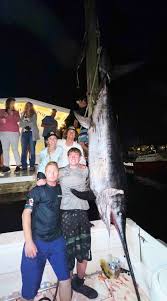
(Young Guns Too fishing team with the current Florida state record swordfish, 2021. It weighed 767.8 pounds.)
In June 2021, Donnie Jackson, Jr. caught the current Mississippi state record swordfish. It weighed 309 pounds, 14.4 ounces.
In August 2021, Peter Schulz caught the first-ever Maryland state record swordfish. It weighed 301 pounds.
The news.maryland.gov article that I got that data from goes on to say “Annapolis resident Peter Schultz, 36, is the first record holder for the Atlantic division – Swordfish (Xiphias gladius). Schultz caught the 301-pound swordfish while participating in the Big Fish Classic Tournament, landing the record-breaking catch roughly 50 miles offshore at Washington Canyon.”
Record-breaking catch, wait, what?
There are no swordfish records in the state of Maryland prior to 2021. Here, the uncredited Intelligence operative from news.maryland.gov bald-fadedly lies that some record was broken, when, in fact, there was no record to be broken.
I have exposed the duplicity of maryland.gov by using what was known in the old days as “fact checking”.
News.maryland.gov attributed Maryland’s first-ever swordfish record the fact that “Deep dropping for swordfish has gained in popularity over the last few years, resulting in more catches of large swordfish.”
Where the largest (and only) swordfish in the history of the state of Maryland has been walked back to merely “large”, and included with numerous-but-unnamed others.
Since we’re studying the subject in a scholarly way, we know that, “Modern deep drop, daytime swordfishing is attributed to the Stanczyk team fishing out of Bud and Mary’s Marina in Islamorada, Florida”. And we know, further, that, in 2003 the Stanczyk team in Islamorada, Florida caught their first swordfish there.
I have once again exposed the duplicity of Maryland.gov by using what was known in the old days as “fact checking”.
If you think that it took almost twenty years for the technique of deep dropping for swordfish to make it from Florida to Maryland, there’s a bridge for sale in Brooklyn that I think it might profit you to look at.
In (month) 2021, the IGFA world male junior record swordfish weighed 282.8 kilograms (623.4 pounds).
In December 2022, John Cruise, Zack Foster and Aaron Barr caught the largest bluefin tuna ever in North Carolina. It weighed 900.1 pounds. It was ineligible for the state record because multiple people were on the line.
In September 2022, Cary Carney caught the North Carolina state record swordfish. It weighed 504.5 pounds.
In July 2023, Mike Scanlan caught the first, only and current Maine state record bluefin tuna for which independent media documenting and photographs exist. It weighed 839.125 pounds.
On July 8, 2023, Andrew Peffly caught the current Ohio hook and line record Buffalo Sucker in Hoover Reservoir. It weighed 50.9 pounds.
On November 6, 2023, Brent McGlone caught the current Ohio bow fishing state record Buffalo Sucker in Lake Erie. it weighed 45.85 pounds.
In 2024, the bluefin tuna winked into existence in the Atlantic Ocean off Maine for the first time in history, as the health of the ether improved to the point where the species could manifest within it.
On February 7, 2024, the Maine Department of Resources posted this on Facebook: “Maine has a new bluefin tuna state saltwater angler record holder: Martin Scanlan from Harpswell landed this 839.125-pound tuna in July 2023 in Harpswell. It took a while for an application for the record to be sent in, but we’re proud to congratulate Martin on his new record!”
There is no mention of a previous record, because the previous Maine bluefin tuna state record from August 1977 is fabricated, e.g., there are here are no independent media accounts of the catch, nor are there any photographs of the fish.
In October 2024, George Stavrakis landed a 164-pound bluefin tuna in the Pacific Ocean off Oregon. It was the largest bluefin tuna ever caught in Oregon.
Oregonlive.com’s Bill Monroe said in comment “It’s believed to be the largest ever landed in Oregon, which doesn’t keep records for saltwater fish. Washington’s record bluefin is 92 pounds and California’s is 395”.
On October 20, 2024, Luc Oldfield caught the current California state record swordfish. It weighed 663.9 pounds.

(Luc Oldfield with the current California state record swordfish, 663.9 pounds, October 20, 2024)
Jeff Miller, Pittsburgh, PA, July 21, 2025
If you’d like to be added to this free mailing list, or know someone who would be, please send me a note at [email protected].
